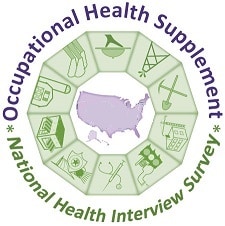Key points
- The NHIS is a good source for worker health surveillance data.
- Detailed work-related information can be found in the 2010 and 2015 surveys.
- The annual NHIS core survey also collects information about employment status and current job.

Occupational Health Supplement
NIOSH sponsored work-related questions in the 2010 and 2015 National Health Interview Surveys (NHIS).
These detailed work-related questions were included in part of the Sample Adult questionnaires. They are sometimes referred to as the "Occupational Health Supplement."
The questions collected more in-depth information on:
- the prevalence of work-related health conditions, and
- exposures to potential psychological and physical job hazards among U.S. workers.
Using the data collected, you can:
- Estimate the prevalence of job exposures and common health conditions within the United States.
- Analyze relationships between job exposures and common health conditions.
- Analyze interactions between work and non-work factors (e.g., tobacco use).
Chart the data
NHIS Core work-related information
The NHIS core survey is also a good source for worker health surveillance data.
Data from the supplements can be combined with other data from the NHIS questionnaires. The annual NHIS core sample adult and family surveys include questions about employment status and current job. These data are used to study general trends in worker health.
Strengths and limitations
- NHIS is a large well-established household survey of health outcomes, health behaviors, and healthcare access among a representative sample of the civilian noninstitutionalized population of the U.S.
- From 1997-2018, the annual NHIS core Sample Adult and Family Questionnaires collected data that can be used to study general trends in worker health.
- Several years of data can be combined to increase the size of industry and occupation subsamples.
- NHIS uses a cross-sectional study design; therefore, causal inferences cannot be made.
- Industry and occupation are not part of the sampling design; Industry and occupation are now only asked 2 out of every 3 years.
- NHIS data are based on self-reported responses; non-specific responses may result in the industry and occupation being misclassified. Information on health outcomes is not validated by a health professional or medical records.
- You may not be able to measure small subpopulations of workers due to possible sampling error. We recommend presenting both point estimates and confidence intervals.
- Note that low-income earners and earners in agriculture and mining may be underrepresented.
